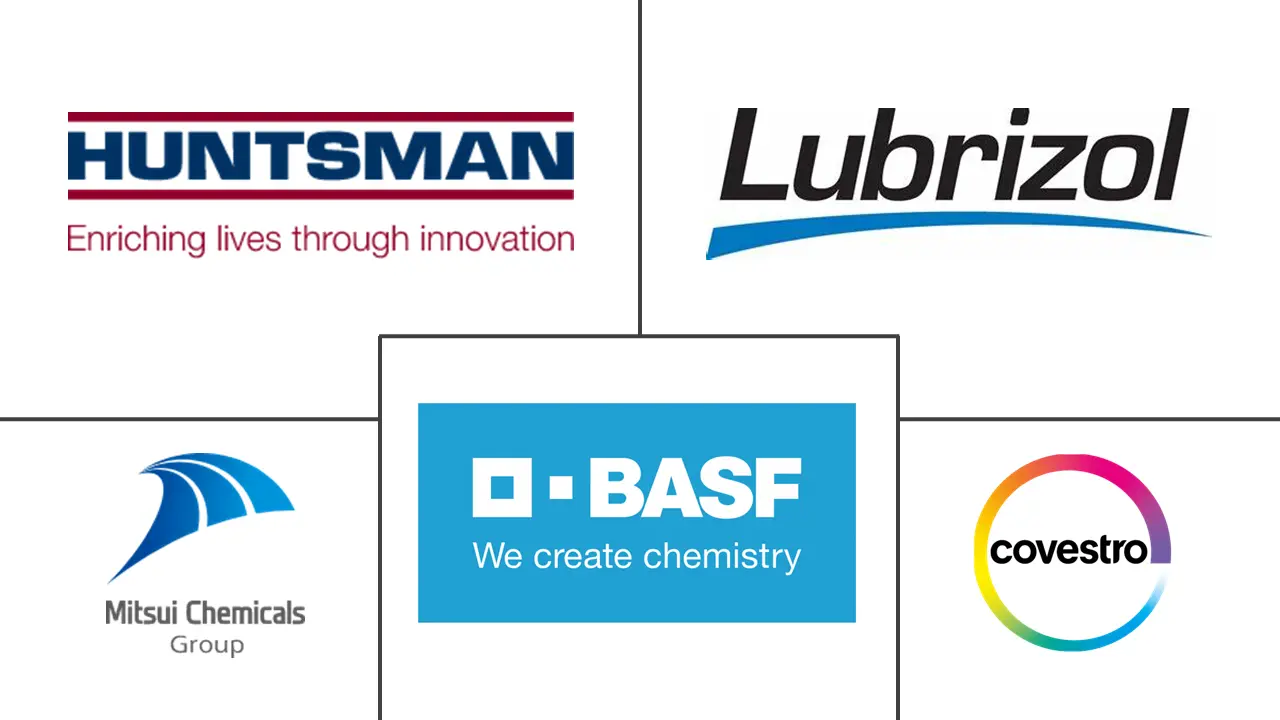Bio-based Polyurethane Market Size and Share
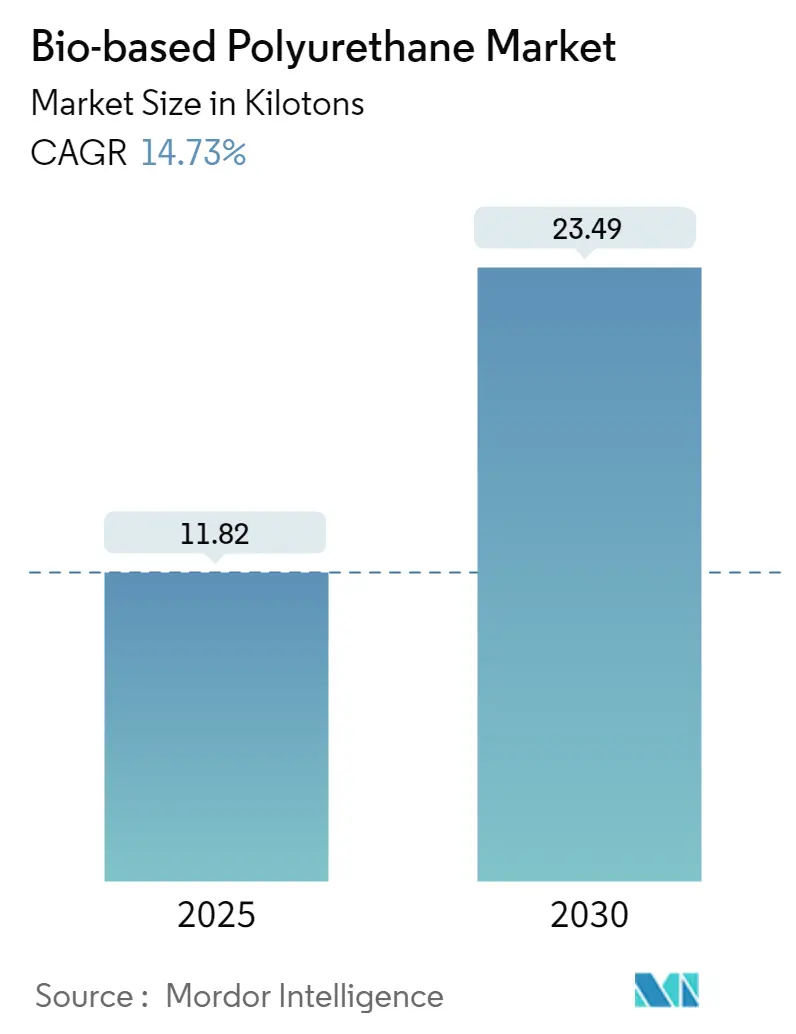
Bio-based Polyurethane Market Analysis by Mordor Intelligence
The Bio-based Polyurethane Market size is estimated at 11.82 kilotons in 2025, and is expected to reach 23.49 kilotons by 2030, at a CAGR of 14.73% during the forecast period (2025-2030).
The bio-based polyurethane industry is experiencing a significant transformation driven by the global shift towards sustainable and environmentally friendly materials. This evolution is particularly evident in the automotive sector, where manufacturers have successfully demonstrated the ability to replace up to 40% of petroleum-based polyols with natural polyurethane in their production processes. The transition to eco-friendly polyurethane alternatives has been further accelerated by stringent environmental regulations and increasing consumer awareness about sustainable products. Companies across various industries are investing in research and development to enhance the performance characteristics of bio-based polyurethanes, making them more competitive with traditional petroleum-based counterparts.
The furniture and bedding sector has emerged as a significant adopter of bio-based polyurethanes, with approximately 90% of upholstered furniture now incorporating polyurethane foam filling. This widespread adoption reflects the industry's commitment to sustainable practices and the material's superior performance characteristics, including durability, comfort, and environmental benefits. Manufacturers are increasingly focusing on developing green polyurethane formulations that maintain the desired physical properties while reducing environmental impact. The integration of renewable raw materials in polyurethane production has led to innovations in product design and manufacturing processes.
The electronics industry is undergoing a substantial transformation with the increasing adoption of sustainable polymer materials in component manufacturing and packaging. The global consumer electronics segment is projected to reach USD 450,752 million by 2025, creating significant opportunities for bio-based polyurethane applications in electronic device protection and insulation. Manufacturers are developing specialized formulations for electronic applications that offer excellent dielectric properties and environmental resistance while maintaining the sustainability benefits of bio-based materials. This trend is particularly evident in the production of protective casings, insulation materials, and component encapsulation.
The construction sector's evolution towards sustainable building materials has created new opportunities for bio-based polyurethane applications. In the United States alone, construction spending reached USD 1,568.8 billion in July 2021, indicating the massive potential for bio-based materials in construction applications. The industry is witnessing increased adoption of bio-based polyurethane in insulation, sealants, and coating applications, driven by the growing emphasis on green building certifications and sustainable construction practices. Manufacturers are developing specialized formulations that meet stringent building codes while offering improved environmental performance and energy efficiency.
Global Bio-based Polyurethane Market Trends and Insights
INCREASING DEMAND FROM THE CONSTRUCTION INDUSTRY IN DEVELOPING COUNTRIES
The construction industry has emerged as a significant driver for bio-based polyurethane demand, particularly in developing nations where infrastructure development is experiencing unprecedented growth. Bio-based polyurethanes are increasingly utilized in various construction applications, including window and door profiles, pipes and guttering, cement, flooring, glass, sealants and adhesives, insulation, building panels, and roofing. These materials offer superior thermal insulation properties, durability, and environmental sustainability compared to traditional construction materials. China exemplifies this trend, with the country's building market representing 20% of global construction investments, making it the largest construction market worldwide. The Chinese government's commitment to infrastructure development is evident in its increased annual infrastructure bond limit to CNY 3.85 trillion in 2022, up from CNY 3.65 trillion in 2021.
The adoption of bio-based polyurethane in construction applications is further driven by the growing emphasis on sustainable building materials and energy-efficient construction practices. The material's versatility in applications such as flexible PU foams for door and window assembly, industrial roof insulation, sound insulation, and waterproof barriers has made it indispensable in modern construction projects. Additionally, water-based co-solvent-free polyurethane coatings are gaining traction in architectural applications, particularly in areas requiring non-flammable properties such as airports, hospitals, car parks, freezing chambers, and commercial spaces. The material's ability to adhere to various construction substrates, including metal, wood, and plastic, while providing environmental benefits, has positioned it as a preferred choice in sustainable construction practices. The use of bio-based adhesive in these applications enhances the material's performance and sustainability.
INCREASING DEMAND FROM ELECTRONIC APPLIANCES MANUFACTURING
The electronics and appliances manufacturing sector has become a major growth driver for the bio-based polyurethane market, driven by increasing demand for sustainable materials in electronic components and devices. Bio-based polyurethanes are frequently utilized in electrical and electronic industries for encapsulating, sealing, and insulating fragile, pressure-sensitive microelectronic components, underwater cables, and printed circuit boards. The material's excellent dielectric and adhesive properties, combined with exceptional solvent, water, and extreme temperature resistance, make it ideal for protecting sensitive electronic components. This trend is particularly evident in India, where the electronics manufacturing industry is projected to expand significantly from USD 75 billion in 2020-21 to USD 300 billion by 2025-26, according to the Ministry of Electronics and Information Technology's Vision document.
The growing adoption of bio-based polyurethane in electronics manufacturing is also driven by its superior performance characteristics in various applications. The material's ability to provide excellent electrical insulation, shock resistance, and adhesion properties has made it essential in the production of cell phones, mobile devices, computers, and TVs. Furthermore, bio-based polyurethane's environmental benefits align with the increasing focus on sustainable manufacturing practices in the electronics industry. The material's ability to maintain high performance while reducing environmental impact has made it particularly attractive to manufacturers seeking to meet both technical requirements and sustainability goals in their production processes. The integration of bio-based coating in electronic components further enhances their durability and environmental compliance.
OTHER DRIVERS
The transportation sector, encompassing automotive, railway, and aerospace industries, has emerged as a significant driver for bio-based polyurethane adoption. The material's versatility is demonstrated in its wide range of applications, from automotive seating systems and interior components to thermal insulation in railways and aerospace applications. This trend is supported by the robust growth in global automotive production, which reached 85.02 million units in 2022, representing a 6% increase from the previous year. The aerospace sector further reinforces this growth trajectory, with the global aerospace services industry projected to exceed USD 3.6 trillion between 2022 and 2041, with the United States and Canada accounting for approximately 30% of the market.
Environmental regulations and sustainability initiatives across industries have become powerful drivers for bio-based polyurethane adoption. The material's ability to replace conventional petroleum-based polyurethanes while maintaining or improving performance characteristics has made it increasingly attractive to manufacturers seeking to reduce their environmental footprint. In the automotive sector, bio-based polyurethane has demonstrated its capability to replace traditional materials in applications such as bumpers, body panels, dashboards, door panels, and various other components. The railway industry's growing interest in sustainable materials has also created opportunities for bio-based polyurethane in applications such as seat cushioning and thermal insulation, contributing to the overall market growth. The use of bio-based plastic in these applications supports the industry's shift towards sustainable polymer solutions. Additionally, the development of renewable chemical technologies is enhancing the performance and sustainability of bio-based polyurethanes, making them a preferred choice in the transportation sector.
Segment Analysis: APPLICATION
Foams Segment in Bio-based Polyurethane Market
The foams segment dominates the global bio-based polyurethane market, accounting for approximately 70% of the total market volume in 2024. This significant market share is attributed to the extensive use of bio-based foam across various applications, including seating systems, headrests, armrests, seat cushioning, and thermal insulation in the construction and automotive industries. The segment is also experiencing the fastest growth rate in the market, driven by increasing demand for sustainable and eco-friendly foam materials in furniture manufacturing, packaging, and construction applications. The versatility of bio-based foam, which can be produced in various shapes and densities while maintaining properties like durability, support, and comfort, has made it particularly attractive for manufacturers looking to reduce their environmental footprint while maintaining product performance.
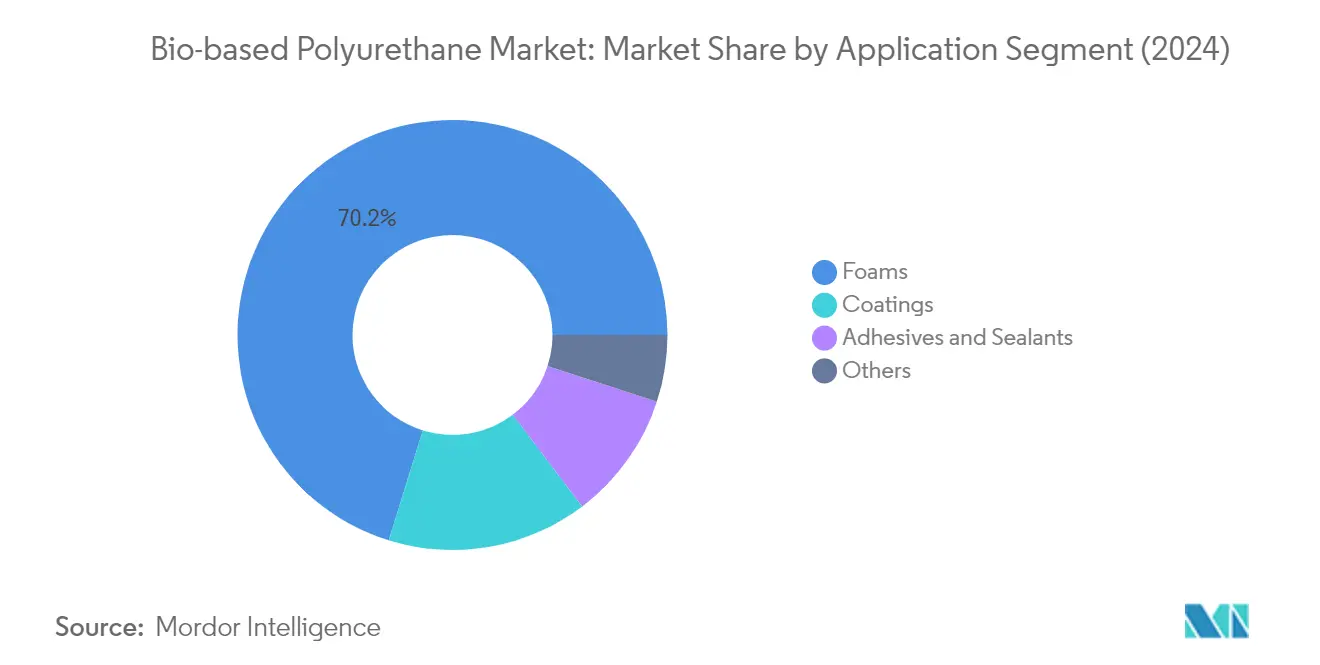
Coatings Segment in Bio-based Polyurethane Market
Bio-based coating represents a significant segment in the market, offering superior environmental benefits compared to conventional coating solutions. These coatings are derived from various bio-based sources such as vegetable oils, terpene, cashew nut-shell liquid, and other bio-renewable sources, making them increasingly popular in sustainable manufacturing processes. The segment's growth is driven by rising demand from architectural applications, automotive plastics coating, and industrial metals protection, where these coatings provide excellent adhesion and chemical resistance without compromising environmental standards. The versatility of bio-based coating in adhering to different substrates while providing protection against corrosion, weathering, and abrasion has made it essential in various industrial applications.
Remaining Segments in Bio-based Polyurethane Market Application
The adhesives and sealants segment, along with other applications, completes the bio-based polyurethane market portfolio. Bio-based adhesive is gaining prominence in the construction, automotive, and packaging industries due to its excellent moisture protection and weather resistance properties. These segments are particularly important in joints of rainwater harvesting pipes, prefabricated building elements, and HVAC applications. Other applications include specialized uses such as polyurethane binders for road maintenance and waterborne polyurethane dispersions for various industrial applications, demonstrating the versatility and expanding scope of bio-based polyurethane products across different sectors.
Segment Analysis: END-USER INDUSTRY
Transportation Segment in Bio-based Polyurethane Market
The transportation segment dominates the bio-based polyurethane market, holding approximately 25% of the total market share in 2024. This significant market position is driven by the extensive use of bio-based PU foams in automotive interior parts, seating systems, headrests, noise reduction components, and trim covers. The segment's growth is further supported by the increasing adoption of bio-based plastic materials in electric vehicles, with major automotive manufacturers incorporating sustainable materials in their production processes. The segment also benefits from the aerospace industry's demand for lightweight and sustainable materials, particularly in aircraft seating and interior components. Additionally, the rising focus on reducing carbon footprint in the transportation sector and stringent environmental regulations have encouraged manufacturers to increase their usage of bio-based polyurethane in various applications.
Electronics Segment in Bio-based Polyurethane Market
The electronics segment is experiencing the fastest growth in the bio-based polyurethane market, with an estimated growth rate of approximately 18% during 2024-2029. This remarkable growth is primarily driven by the increasing demand for sustainable electronic components and encapsulation materials. The segment's expansion is supported by the growing adoption of bio-based polyurethanes in manufacturing processes for electronic devices, particularly in encapsulating and protecting sensitive electronic components. The rise in consumer electronics production, coupled with the industry's shift towards environmentally friendly materials, has created substantial opportunities for bio-based polyurethane applications. Furthermore, the segment's growth is bolstered by innovations in electronic manufacturing processes and the development of new bio-based formulations specifically designed for electronic applications.
Remaining Segments in End-User Industry
The other significant segments in the bio-based polyurethane market include construction, furniture and bedding, packaging, and footwear and textile industries. The construction sector utilizes bio-based polyurethane in insulation, sealants, and coating applications, while the furniture and bedding segment employs it in manufacturing comfortable and sustainable furniture products. The packaging industry leverages bio-based polyurethane for protective packaging solutions and sustainable packaging materials. The footwear and textile segment incorporates these materials in manufacturing eco-friendly footwear components and textile coatings. Each of these segments contributes uniquely to the market's growth, driven by increasing environmental awareness and sustainable manufacturing practices across industries.
Bio-based Polyurethane Market Geography Segment Analysis
Bio-based Polyurethane Market in Asia-Pacific
The Asia-Pacific region represents a dominant force in the global bio-based polyurethane market, driven by rapid industrialization and increasing adoption of sustainable materials. The region encompasses major economies including China, India, Japan, and South Korea, each contributing significantly to market growth through various end-use industries such as construction, automotive, and electronics. The presence of leading manufacturers, growing environmental awareness, and supportive government policies promoting sustainable polyurethane have created a robust ecosystem for market expansion in this region.
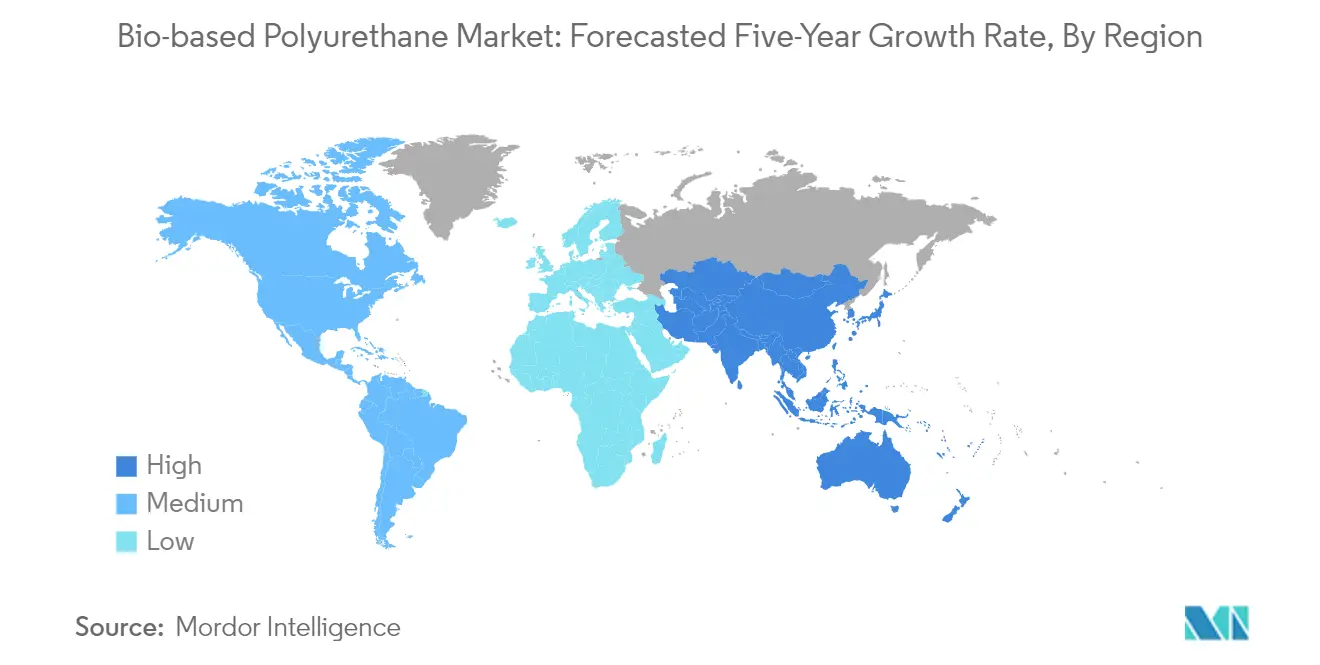
Bio-based Polyurethane Market in China
China stands as the powerhouse of the Asia-Pacific bio-based polyurethane market, commanding approximately 58% of the regional market share. The country's dominance is attributed to its massive manufacturing base, particularly in the electronics, automotive, and construction sectors. The Chinese market benefits from extensive research and development activities, strong government support for sustainable materials, and increasing domestic demand for eco-friendly products. The presence of major manufacturing facilities and a growing emphasis on reducing carbon emissions has positioned China as a crucial player in the regional market landscape.
Bio-based Polyurethane Market Growth in China
China continues to demonstrate exceptional growth potential in the bio-based polyurethane market, with an anticipated growth rate of approximately 22% during 2024-2029. This remarkable growth is driven by increasing investments in sustainable manufacturing practices, rising environmental consciousness, and expanding applications in various industries. The country's commitment to reducing environmental impact, coupled with technological advancements and innovation in bio polyol and other bio-based foam materials, positions it as a key growth driver in the Asia-Pacific region.
Bio-based Polyurethane Market in North America
North America represents a significant market for bio-based polyurethane, characterized by advanced technological capabilities and a strong focus on sustainable development. The region, comprising the United States, Canada, and Mexico, demonstrates robust market dynamics driven by increasing environmental regulations and growing demand for eco-friendly materials. The presence of major industry players, extensive research and development activities, and a strong emphasis on reducing carbon footprint contribute to the region's market growth.
Bio-based Polyurethane Market in United States
The United States dominates the North American bio-based polyurethane market, holding approximately 81% of the regional market share. The country's market leadership is supported by its advanced manufacturing capabilities, strong presence in key end-use industries, and increasing adoption of sustainable materials. The robust automotive sector, growing construction industry, and rising demand for eco-friendly consumer products continue to drive market growth in the United States.
Bio-based Polyurethane Market Growth in United States
The United States maintains its position as the fastest-growing market in North America, with an expected growth rate of approximately 14% during 2024-2029. This growth is fueled by increasing investments in sustainable technologies, stringent environmental regulations, and rising consumer awareness about eco-friendly products. The country's strong focus on research and development, coupled with growing applications in various industries, continues to drive market expansion.
Bio-based Polyurethane Market in Europe
Europe maintains a strong position in the global bio-based polyurethane market, with a well-established manufacturing base and stringent environmental regulations. The region encompasses key markets including Germany, the United Kingdom, Italy, France, and Spain, each contributing significantly to market growth. The European market benefits from advanced technological capabilities, a strong focus on sustainability, and increasing adoption of plant-based polyurethane across various industries.
Bio-based Polyurethane Market in Germany
Germany emerges as the largest market for bio-based polyurethane in Europe, driven by its robust automotive industry, strong manufacturing base, and leading position in sustainable technologies. The country's market leadership is supported by extensive research and development activities, the presence of major industry players, and strong government support for eco-friendly materials. German manufacturers continue to innovate and develop new applications for bio-based polyurethane, maintaining their competitive edge in the European market.
Bio-based Polyurethane Market Growth in Germany
Germany demonstrates strong growth potential in the bio-based polyurethane market, driven by increasing investments in sustainable technologies and growing demand from various end-use industries. The country's commitment to environmental sustainability, coupled with its strong industrial base and technological capabilities, positions it as a key growth driver in the European market. The automotive and construction sectors continue to be major contributors to market growth in Germany.
Bio-based Polyurethane Market in Rest of the World
The Rest of the World region, encompassing Brazil, Saudi Arabia, and South Africa, presents diverse opportunities in the bio-based polyurethane market. Each country demonstrates unique market dynamics influenced by local industrial development, environmental regulations, and economic conditions. Brazil emerges as both the largest and fastest-growing market in this region, driven by its strong manufacturing base and increasing focus on sustainable materials. The region shows promising growth potential, particularly in construction and automotive applications, supported by increasing industrialization and growing environmental awareness.
Competitive Landscape
Top Companies in Bio-based Polyurethane Market
The leading companies in the bio-based polyurethane market are demonstrating a strong commitment to sustainable innovation through the continuous development of eco-friendly polyurethane products and manufacturing processes. These organizations focus on expanding their production capacities while simultaneously strengthening their distribution networks across multiple regions. Strategic partnerships and collaborations, particularly in research and development, have become increasingly common as companies seek to develop custom solutions for specific end-user industries. Companies are also investing heavily in backward integration to gain competitive advantages in raw material procurement and cost management. The emphasis on developing bio-based alternatives to traditional polyurethane products reflects the industry's response to growing environmental concerns and regulatory pressures.
Consolidated Market with Strong Global Players
The bio-based polyurethane market exhibits a consolidated structure dominated by large multinational chemical conglomerates with extensive manufacturing capabilities and robust distribution networks. These major players leverage their established presence across multiple regions and their ability to serve diverse end-user industries, from automotive and construction to electronics and furniture. The market is characterized by high entry barriers due to significant capital requirements and the need for advanced technological capabilities, which has contributed to maintaining the dominant position of established players.
The competitive landscape shows limited merger and acquisition activity, with companies primarily focusing on organic growth through capacity expansion and product development. Regional players typically operate in specific market segments or geographical areas, often specializing in particular applications or end-user industries. The presence of strong backward integration among leading players, particularly in raw material production, provides them with significant cost advantages and better control over the supply chain, making it challenging for new entrants to compete effectively.
Innovation and Sustainability Drive Future Success
For incumbent companies to maintain and expand their market share, developing innovative sustainable polymer solutions that meet increasingly stringent environmental regulations while maintaining cost competitiveness is crucial. Success factors include establishing strong relationships with raw material suppliers, investing in research and development for new applications, and building efficient distribution networks. Companies must also focus on developing customized solutions for specific end-user industries while maintaining flexibility to adapt to changing market demands.
Emerging players seeking to gain ground in the market need to focus on specialized market segments or regional opportunities where they can build competitive advantages. This includes developing unique value propositions through technological innovation or superior customer service. The increasing focus on environmental sustainability and potential regulatory changes favoring renewable polymer materials presents opportunities for new entrants to differentiate themselves. Companies must also consider the concentration of end-users in key industries and develop strategies to address the threat of substitution from conventional polyurethane products while building strong relationships with key stakeholders in the value chain.
Bio-based Polyurethane Industry Leaders
-
The Lubrizol Corporation
-
Covestro AG
-
BASF SE
-
Mitsui Chemicals Inc.
-
Huntsman International LLC
- *Disclaimer: Major Players sorted in no particular order
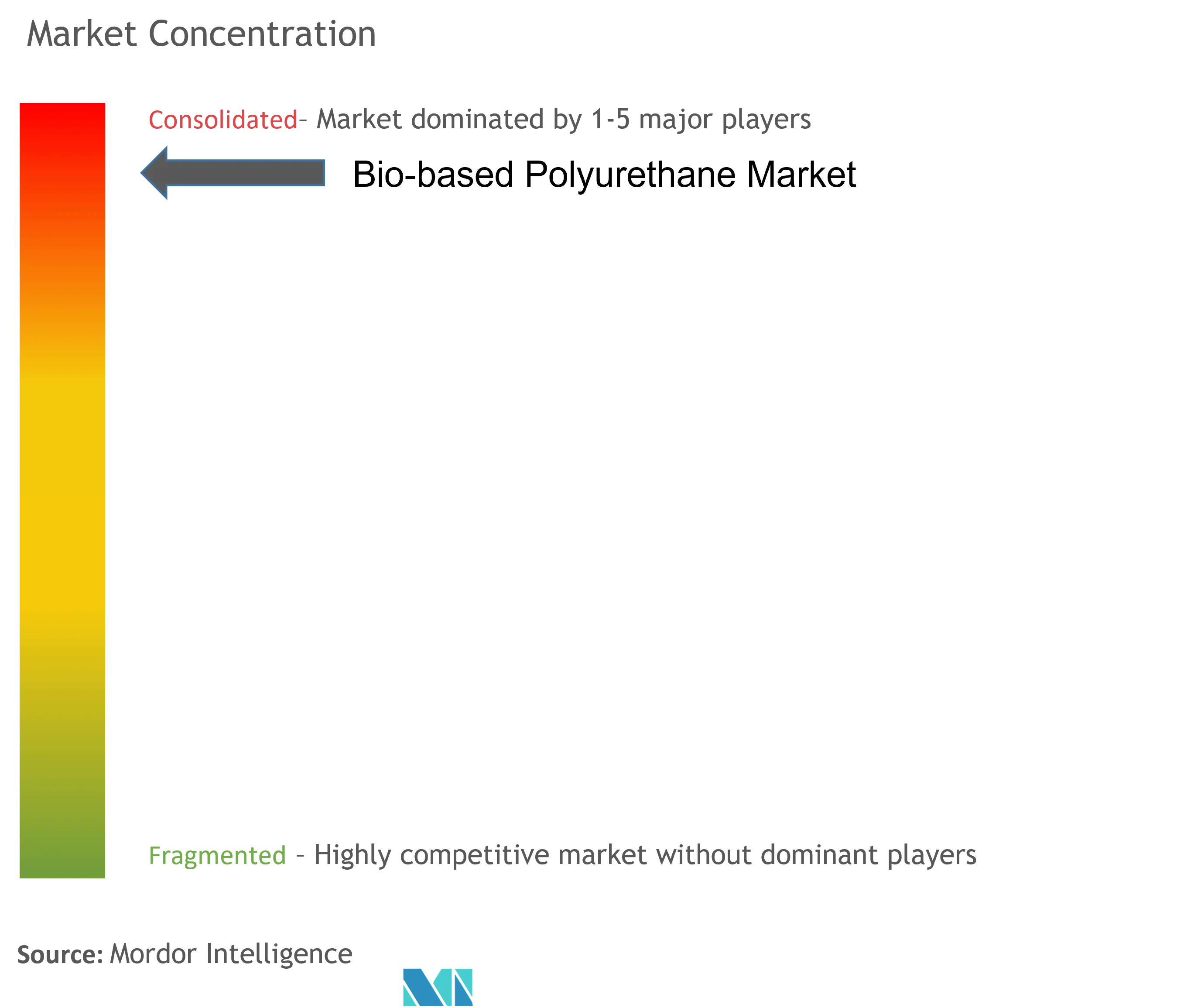
Recent Industry Developments
- November 2022: Covestro AG, a materials supplier, and Coleitec, a Chinese high-tech company, signed a strategic partnership agreement to accelerate the application development of polyurethane (PU) composite materials and further expand their market-oriented cooperation.
- October 2022: Carbon's EPU 44 was honored as the 2022 Polyurethane Innovation Award winner by the American Chemical Council's Centre for the Polyurethanes Industry (CPI). The Innovation Prize is highly esteemed in the polyurethane industry, recognizing companies and individuals whose vision and determination have led to the introduction of life-improving products, technologies, and projects to the market.
Global Bio-based Polyurethane Market Report Scope
Bio-based polyurethanes are an important class of renewable thermosets. They can be 10% to 100% bio-based and are typically prepared by reacting natural oil polyols with diisocyanates.
The market is segmented by application, end-user industry, and geography. By application, the market is segmented into foams, coatings, adhesives, sealants, and other applications (polyurethane binders, polyurethane dispersions). By end-user industry, the market is segmented into transportation, footwear and textile, construction, packaging, furniture and bedding, electronics, and other end-user industries (biomedical, fertilizer industry). The report also covers the market size and forecasts for the bio-based polyurethane market in 15 countries across the major regions.
For each segment, the market sizing and forecasts have been done based on volume (kilotons).
| Foams |
| Coatings |
| Adhesive and Sealants |
| Other Applications (Polyurethane Binders, Polyurethane Dispersions) |
| Transportation |
| Footwear and Textile |
| Construction |
| Packaging |
| Furniture and Bedding |
| Electronics |
| Other End-user Industries (Biomedical, Fertilizer Industry) |
| Asia-Pacific | China |
| India | |
| Japan | |
| South Korea | |
| Rest of Asia-Pacific | |
| North America | United States |
| Canada | |
| Mexico | |
| Europe | Germany |
| United Kingdom | |
| Italy | |
| France | |
| Spain | |
| Rest of Europe | |
| Rest of the World | Brazil |
| Saudi Arabia | |
| South Africa | |
| Rest of the Countries |
| Application | Foams | |
| Coatings | ||
| Adhesive and Sealants | ||
| Other Applications (Polyurethane Binders, Polyurethane Dispersions) | ||
| End-user Industry | Transportation | |
| Footwear and Textile | ||
| Construction | ||
| Packaging | ||
| Furniture and Bedding | ||
| Electronics | ||
| Other End-user Industries (Biomedical, Fertilizer Industry) | ||
| Geography | Asia-Pacific | China |
| India | ||
| Japan | ||
| South Korea | ||
| Rest of Asia-Pacific | ||
| North America | United States | |
| Canada | ||
| Mexico | ||
| Europe | Germany | |
| United Kingdom | ||
| Italy | ||
| France | ||
| Spain | ||
| Rest of Europe | ||
| Rest of the World | Brazil | |
| Saudi Arabia | ||
| South Africa | ||
| Rest of the Countries | ||
Key Questions Answered in the Report
How big is the Bio-based Polyurethane Market?
The Bio-based Polyurethane Market size is expected to reach 11.82 kilotons in 2025 and grow at a CAGR of 14.73% to reach 23.49 kilotons by 2030.
What is the current Bio-based Polyurethane Market size?
In 2025, the Bio-based Polyurethane Market size is expected to reach 11.82 kilotons.
Who are the key players in Bio-based Polyurethane Market?
The Lubrizol Corporation, Covestro AG, BASF SE, Mitsui Chemicals Inc. and Huntsman International LLC are the major companies operating in the Bio-based Polyurethane Market.
Which is the fastest growing region in Bio-based Polyurethane Market?
Asia Pacific is estimated to grow at the highest CAGR over the forecast period (2025-2030).
Which region has the biggest share in Bio-based Polyurethane Market?
In 2025, the Europe accounts for the largest market share in Bio-based Polyurethane Market.
What years does this Bio-based Polyurethane Market cover, and what was the market size in 2024?
In 2024, the Bio-based Polyurethane Market size was estimated at 10.08 kilotons. The report covers the Bio-based Polyurethane Market historical market size for years: 2019, 2020, 2021, 2022, 2023 and 2024. The report also forecasts the Bio-based Polyurethane Market size for years: 2025, 2026, 2027, 2028, 2029 and 2030.
Page last updated on:
